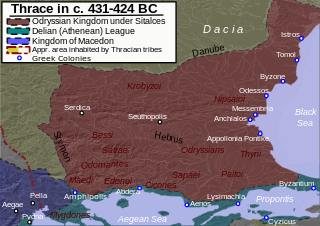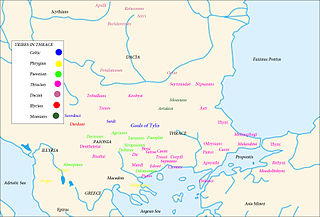 W
WThe Agrianes or Agrianians, were a tribe whose country was centered at Upper Strymon, in present-day western Bulgaria, and also held areas of southeasternmost Serbia in the ancient Roman provinces of Dacia Mediterranea, at the time situated north of the Dentheletae. In the times of Philip II, the territory of the Agrianes was administered by Pella. They were crack javelin throwers and an elite unit of Alexander the Great's light infantry, who fought under the command of General Attalus.
 W
WThe Bessi were an independent Thracian tribe who lived in a territory ranging from Moesia to Mount Rhodope in Northern Thrace, but are often mentioned as dwelling about Haemus, the mountain range that separates Moesia from Thrace and from Mount Rhodope to the northern part of Hebrus.
 W
WThe Bisaltae were a Thracian people on the lower Strymon river, who gave their name to Bisaltia, the district between Amphipolis and Heraclea Sintica on the east and Crestonice on the west. They also made their way into the peninsulas of Acte and Pallene in the south, beyond the river Nestus in the east, and are even said to have raided Cardia.
 W
WThe Dentheletae, also Danthaletae (Δανθαλῆται) or Denseletae, were a Thracian tribe that in antiquity lived near the sources of the River Strymon, and are mentioned in texts by Polybius, Cassius Dio, Tacitus and by Livy. They lived in the neighbourhoods of the modern towns Kyustendil and Dupnitsa, stretching to as far as the mountains to the west towards the valleys of the Morava and the Vardar river, with territories situated next to the Thracian tribes Agrianes and the Maedi. Their main city, called Dentheletica, was presumably Pautalia as this was the capital of the Roman region Dentheletica. They possibly built fortifications around Stara Planina in the 1st century BC, lived around Sofia and Skaptopara was their town.
 W
WThe Dii were an independent Thracian tribe, swordsmen, who lived among the foothills of Mount Rhodope in Thrace, and particularly in the east bank of Nestos, from the springs to the Nestos gorge. They often joined the ranks of organized armies as mercenaries or volunteers. Thucydides declared that they were the most warlike infantry in Sitalkes' army.
 W
WThe Getae or Gets were several Thracian tribes that once inhabited the regions to either side of the Lower Danube, in what is today northern Bulgaria and southern Romania. Both the singular form Get and plural Getae may be derived from a Greek exonym: the area was the hinterland of Greek colonies on the Black Sea coast, bringing the Getae into contact with the ancient Greeks from an early date. Although it is believed that the Getae were related to their westward neighbours, the Dacians, several scholars, especially in the Romanian historiography, posit that the Getae and the Dacians were the same people.
 W
WThe Laeaeans were a Paeonian tribe who in the 4th century BC lived adjacent to the Agrianes, another Paeonian tribe, along the upper course of the Strymon river, at the western edge of Thrace. They were not incorporated into the Odrysian state or the Paeonian state, remaining an independent tribe outside the borders of those kingdoms. According to Thucydides, the Laeaeans, along with the Agrianes, the Thracian Dii, and other tribes, joined Sitalkes in his unsuccessful campaign against Perdiccas II of Macedon. The coins issued by the Laeaeans are judged to be of crude workmanship, and seem to be imitations of finer minted coins issued by other neighboring Paeonian tribes such as the Derrones. A typical coin bears the inscription LAIAI (Laeaeans) on the obverse, and a Pegasus in a double linear square on the reverse. It is unclear whether or not the Laeaeans were conquered by Philip II or Alexander the Great, although their neighbors are recorded by historians such as Arrian as client kings.
 W
WThe Maedi were a Thracian tribe in antiquity. In historic times, they occupied the area between Paionia and Thrace, on the southwestern fringes of Thrace, along the middle course of the Strymon, between the Kresna Gorge and the Rupel Pass. Strabo says that the Maedi bordered eastward on the Thunatae of Dardania, and that the Axius flowed through their territory.
 W
WThe Odrysian Kingdom was a state union of over 40 Thracian tribes and 22 kingdoms that existed between the 5th century BC and the 1st century AD. It consisted mainly of present-day Bulgaria, spreading to parts of Southeastern Romania, parts of Northern Greece and parts of modern-day European Turkey.
 W
WThe Thracians were an Indo-European people who inhabited large parts of Eastern and Southeastern Europe in ancient times. They spoke the Thracian language and shared a common culture. The study of the Thracians is known as Thracology.
 W
WThe Triballi were an ancient tribe whose dominion was around the plains of modern southern Serbia, northern part of North Macedonia and western Bulgaria, at the Angrus and Brongus and the Iskar River, roughly centered where Serbia and Bulgaria are joined.
 W
WTylis or Tyle was a capital of a short-lived Balkan state mentioned by Polybius that was founded by Celts led by Comontorius in the 3rd century BC. Following their invasion of Thrace and Greece in 279 BC, the Gauls were defeated by the Macedonian king Antigonus II Gonatas in the Battle of Lysimachia in 277 BC, after which they turned inland to Thrace and founded their kingdom at Tylis. It was located near the eastern edge of the Haemus (Balkan) Mountains in what is now western Bulgaria. Some bands of Celts, namely the Tectosages, Tolistobogii and Trocmi, did not settle in Thrace, but crossed into Asia Minor to become known as the Galatians. The last king of Tylis was Cavarus who maintained good relations with the city of Byzantium. His capital was destroyed by the Thracians in 212 BC and this was also the end of his kingdom. The modern Bulgarian village of Tulovo in Stara Zagora Province now occupies the site.